Welcome Home!
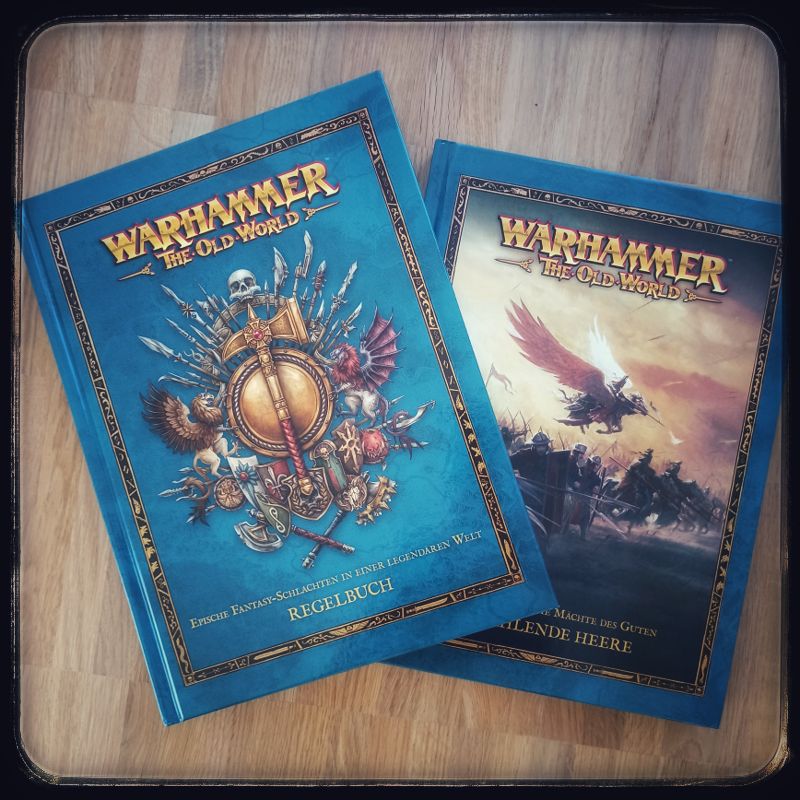
Finally, finally, Warhammer: The Old World was released in January and arrived in my home a few days ago. I first bought the rulebook and the “Forces of Fantasy” compendium with the rules for my beloved Bretons, among others. Why am I jumping on the hype train, what does it have to do with movieminis.de and how do I like it now?
Why do I write about Warhammer: The Old World at all?
Legitimate question. The blog is avowedly about my love for movies and pop culture in general, and of course how that translates into my miniature collection. Clear concepts bring clear boundaries and it begs the question, what do I do if I want more? I already wrote about it in an article about Warhammer 40.000: Of course, this can and must also take place here, but to a reduced extent. My long-suffering readers already know that I can’t cope with the back and front of my projects. Warhammer alone is enough of a hobby, and nowadays you can hardly find enough time and money for anything else. The fortunate circumstance with the latter is just that: I already own the miniatures. How expensive can the rest be? But more on that later.
That leaves the time. Well, that’s my Achilles’ heel anyway. But in this case, nostalgia has once again beaten reason. And Games Workshop generally seems to be calculating with this.
Why am I jumping on the hype train now?
Nostalgia, that’s it. I have a lot of love for Warhammer Fantasy (aka roughly The Old World), but the emotional situation is very difficult. But first things first: Warhammer fever hit me in September 1997 at the tender age of 11. Back then, the sheer range of Warhammer Fantasy, Warhammer 40,000, Epic 40,000, soon Gorkamorka, soon Necromunda etc. with all their armies, backstories and tie-ins was almost overwhelming and actually insanely cool in all facets. Bretons were my first love, but unfortunately GW’s manipulative way of publishing and my own seductiveness meant that over the years I actually wanted everything and started various systems and armies. Unfortunately, that hasn’t changed to this day.
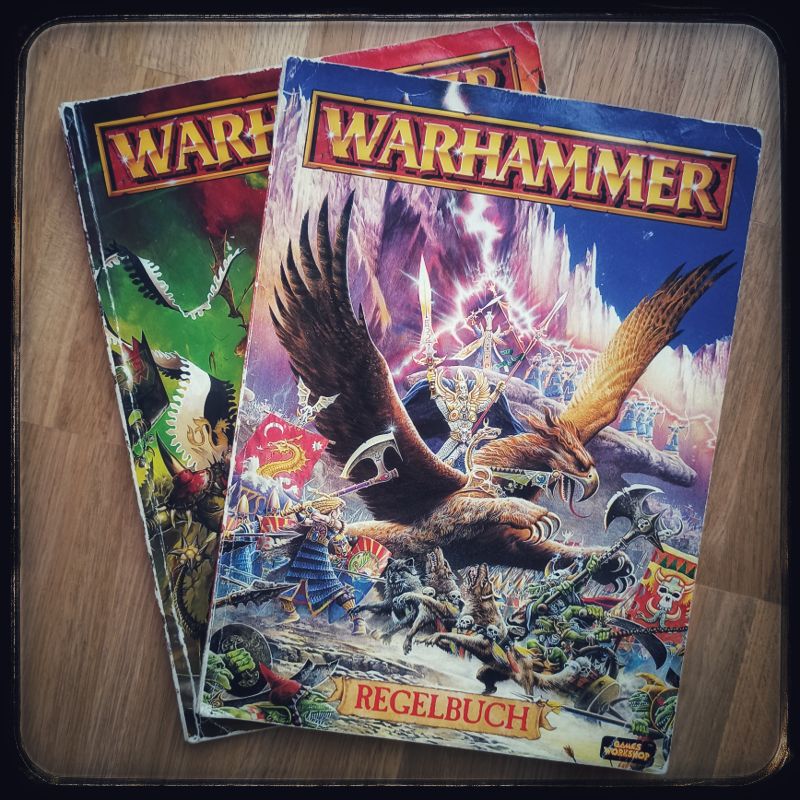

Despite all my love, I stopped playing the hobby at some point. The 7th edition of Warhammer Fantasy was in the starting blocks and I said goodbye completely. So in a way, I quit when Warhammer was still cool. I came back in 2016 and Warhammer Fantasy wasn’t even around anymore. I never had any interest in Age of Sigmar. I actually only got back into the hobby in the first place because of all the alternatives. It was all the pop culture miniatures that drew me back in. That’s what this blog is about. That’s why I was never one of those who mourned Warhammer too much. I had no reason to condemn AoS and I didn’t call for the Old World to be brought back. I didn’t get back into 40k either, although I still want to paint my miniatures and maybe buy a few new ones.
Nevertheless, Games Workshop grabbed me by the balls and I let it happen. I think it’s really nice to get involved with Warhammer again. Ordering the rulebook, waiting for it, driving to the packing station with a bit of excitement, unpacking it and holding it in my hand is something special. Yes, it’s different to holding any other rulebook in your hand. I can’t say exactly why that is. Because I completely skipped the 7th and 8th editions and don’t even know the rulebooks. I could just as easily have bought the 8th edition rulebook on eBay and discovered a new edition. But it takes the feeling of wanting to take the magic of the moment with you. The game is back, even if it’s now called Warhammer: The Old World. But I’m back too and all is well.
What is my plan for Warhammer: The Old World?
Well, we don’t quite know yet where the journey with the system will take us. Currently, the Bretons and Khemri have been released and the Orcs have been announced. We can assume that all armies will be released in the two compendiums. We are supposed to believe that all other armies will be left to gather dust as legacy armies and will not be supported. I can’t imagine that with the best will in the world. With Lizardmen, Skaven, Dark Elves and others, this would affect some of the most popular armies in Warhammer Fantasy. If TOW is a success (which it seems to be), GW won’t let that lie. The theory that the Lizardmen only got a very nice new range for AoS last year and that new releases are possibly planned for the others for AoS doesn’t seem entirely implausible to me. They could then be revived for TOW at a later date. Hands down: The return of Warhammer-whatever-it’s-called-now shows that nothing is impossible.
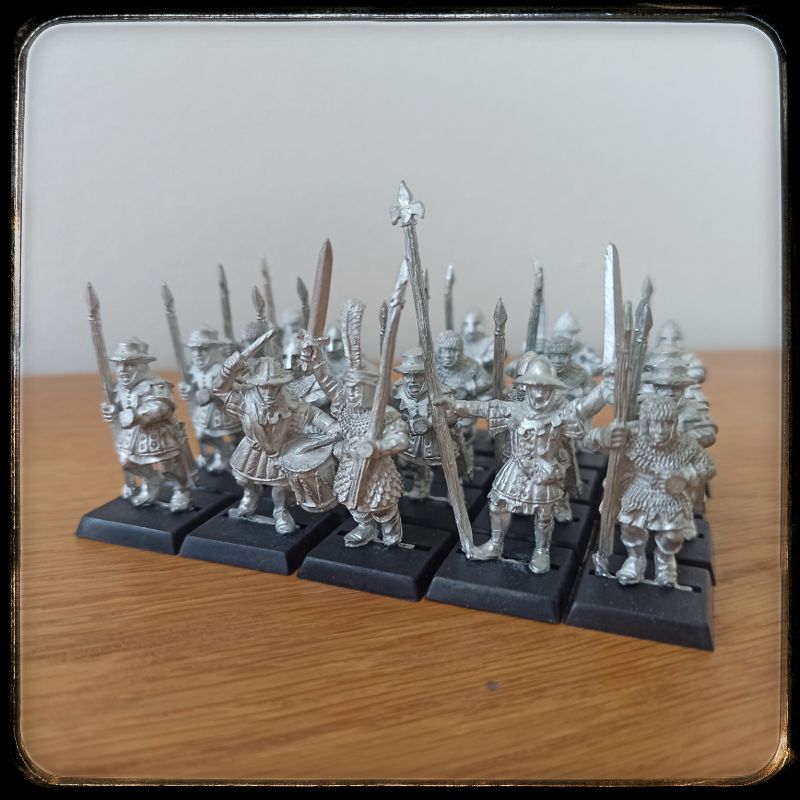
I still have a pretty impressive Breton army with miniatures from the 4th/5th and 6th editions. I probably won’t buy anything new for it. From my point of view, I hardly need anything except the Grail Knights. I’m a bit shocked at the prices for the miniatures apart from the old plastic regiments and won’t pay that, but I don’t have to. In case of doubt, various 3D printing providers help me. I find Highlands Miniatures in particular to be quite close to the 6th edition designs and therefore very suitable for my Bretons. You’ll probably see a difference, but I’m not planning to mix figures within the regiments. If I print a unit of Grail Knights, then it will fit, especially given the financial savings.
On the other hand, the prices of the old Made to Order miniatures were a positive surprise. With the Bretons, I was only interested in the four Palladins on foot, as these are some of the few figures I had never owned. In previous years, some of the miniatures were priced at 30-40€ each on the relevant portals, which was always too much for me. GW now charges 12€ per miniature, which is why I had to buy all 4. I already have the rest of the MtO stuff. But if the pattern continues like this, I’ll certainly make one or two more purchases of other armies out of nostalgic feelings (Stone Trolls, I look at you!).
The other army I still have and love no less is my Dark Elves force from 6th edition. Fortunately, I’m no longer looking for anything for them and I’m not sad that they’re not properly supported. Because let’s be honest: the chances of me playing Warhammer: The Old World in the next few years are close to zero. I couldn’t really care less. I could have continued to play an old edition of Warhammer and possibly would have done so. Maybe I don’t even want to play TOW because I don’t agree with the system? But only a closer look can show that:
Warhammer: The Old World – The Rulebook
So, let’s take a closer look at the matter. I bought the TOW rulebook and the “Forces of Fantasy” compendium, both in German, as well as the 4 MtO Paladins. That should be it for now. When I play a system (even if it’s only in theory), I want to make my collection playable. Knowing the rules is therefore important to me.
One thing was clear from the outset: the miniatures will not be rebased. TOW sometimes uses larger bases than Warhammer Fantasy. My figures won’t be touched, especially as I don’t even know yet whether I’d prefer to play an old edition. Instead, I would work with base adapters. They’re not a visual highlight either, but as a regimental base I think they’re justifiable and definitely better than rebasing several 20-man regiments. Apart from that, there should be relatively few changes to the existing army.
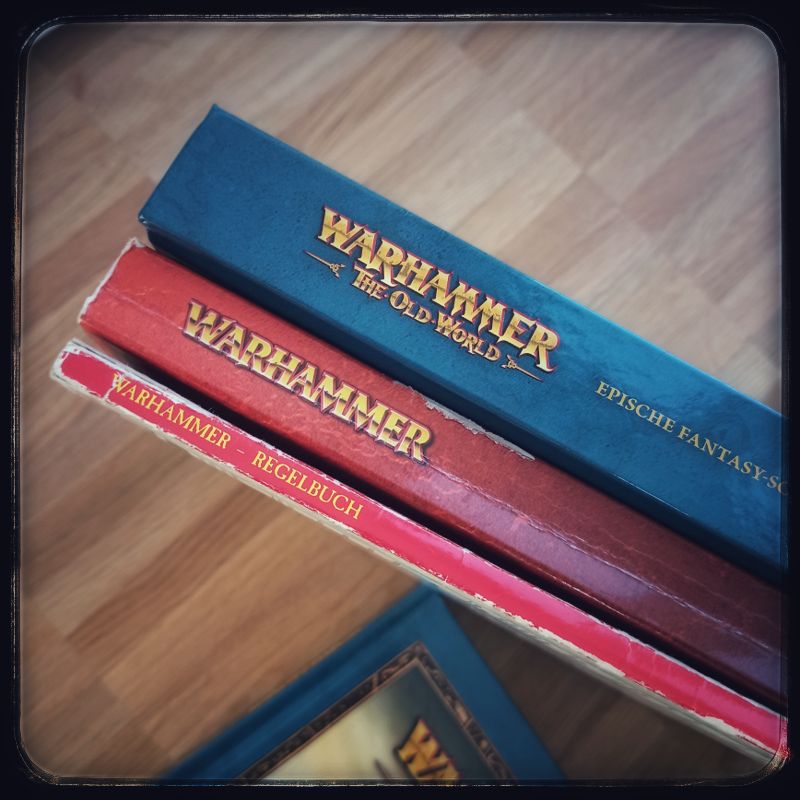
First of all, the rulebook is quite a chunk. Hardcover, full color, it makes a high-quality impression. GW wants 55€ for the german version, which is pretty steep for a rulebook without any other necessary game paraphernalia. But it seems to be within the usual GW range when I look at the AoS and WH40k publications of the last few years.

©Games Workshop
I was irritated by the fact that no designers are listed. Unless I have overlooked something, it is not clear from the book who wrote it. I don’t know if this is standard GW practice today, but it used to be different. You knew that the Perrys sculpted the original Lord of the Rings range or that Chris Fitzpatrick designed the 6th edition Dark Elves, which I love. That makes it personal, so you can follow the designers other projects and in the case of Fitzpatrick I always have an eye on his current work at Crocodile Games.
The 6th edition Warhammer rulebook gives credits to all involved. From today’s perspective, legendary names are gathered together. Pristley and Pirinen, Cavatore, Thornton, Stillman and others. I only know illustrators like Blanche, Kopinski or Gallagher because of their work for GW. Reading the familiar names today is worth a lot. It’s a shame that they’ve completely dispensed with this and no longer name artists. Sorry, this digression was necessary, but it’s really regrettable.
The rulebook comprises a whopping 352 pages and is divided into two sections. Don’t worry, these aren’t all rules, but unfortunately the majority of them are. The first 90 pages give a rough overview of the hobby (“…what you need to play…”) and provide a fairly detailed introduction to the background. It’s debatable whether this is needed in such detail in the rulebook, but I liked it. The old world of Warhammer Fantasy had been destroyed and it never came back. Warhammer: The Old World is called that for a reason. It’s not the same world, it’s set thousands of years before the previously known Old World. It is effectively the prequel to Warhammer Fantasy and the prequel-prequel to Age of Sigmar. Newcomers need to be told what it’s all about and even veterans need to be given an idea of where the races currently stand and what their intentions are. And it’s quite clear: the background story and world building is one of the great strengths of the entire Warhammer universe and one of the main reasons why many of us simply can’t get away from it. Despite its length, I find this comprehensive background section in the rulebook useful and profitable. Once you’ve worked your way through it, you’re well oriented and informed.
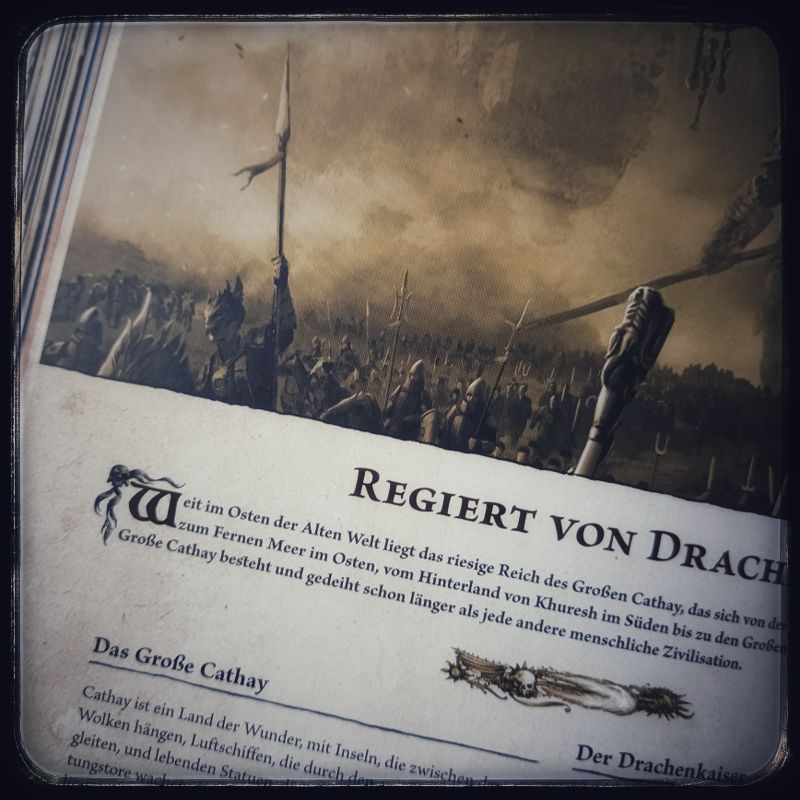
©Games Workshop
The Rules
Well, the rules unfortunately make up the rest of the book, with only one part dealing with the game mechanics. I would say 185 pages are devoted to the rules. The rest deals with creating the army list, dealing with point costs, different types of battles or campaigns and then once again the complex topic of magic and magic items.
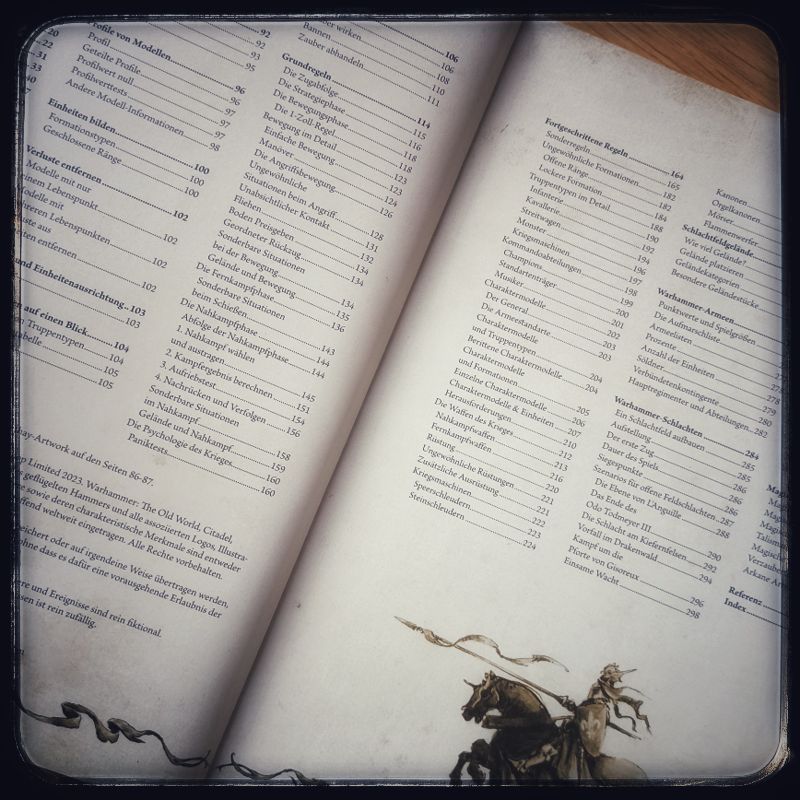
The rules section first deals with basic principles of the game, profiles, unit formation and loss distance, lines of sight, etc., followed by the basic rules. This is followed by advanced rules, without which you would not play at all. Rules for command divisions, special character models or war machines will be something even beginners will want to know very quickly.
Personally, I don’t really mind all that much, as I already know most of the rules and only have to skim through them and look for changes. For newcomers, however, this is heavy. Anyone who has played Skirmisher before will probably be put off here. Basically, the layout of the book is appealing, the pages are all brownish in color and are meant to look like old parchment. Practically every page contains the usual beautiful and atmospheric illustrations and/or graphic representations to clarify the rules. It all looks good, but of course it also takes up space. On the other hand, the pages are relatively tightly printed, and the design variety requires the eye and concentration. I would have liked the old division of the 5th edition into rulebook and sourcebook very much here.
By and large, of course, the game has remained true to itself. My experience only goes back to the end of 6th edition, so I’m not sure what the rules were in 7th and 8th edition. But the general tone seems to be that the rules are a best of the past editions with a bit of Lord of the Rings thrown in. You’d have to look at some of the details now. The first thing that stands out for me is the structuring of the moves:
| 6. Edition WHFB | WH: TOW |
| 1. Start of the turn | 1. Strategy Phase |
| 2. Movement Phase | 2. Movement Phase |
| 3. Shooting Phase | 3. Shooting Phase |
| 4. Magic | 4. Combat Phase |
| 5. Combat Phase |
The magic phase has now been merged with the start of the turn to form the strategy phase and the “Orders” item for playing certain special rules has been added. This is actually nice, as some tactical options are dealt with right at the start and this can change the subsequent movement phase once again. It is a pity, however, that you slavishly stick to the old IGOUGO (I go, you go, i.e. you deal with everything one after the other and the other player waits passively for the most part during your turn). This also makes the strategy phase very one-sided. Tactical finesse could have been incorporated here by allowing the opponent to disrupt the “enemy” strategy phase.
I had completely forgotten how complex the movement rules are. I haven’t played Rank&File since I left Warhammer about 20 years ago. Skirmishers, by their very nature, have no rules for turning regiments, maneuvering around terrain and the like. Roughly speaking, I haven’t seen any anomalies. The movement rules should not have changed much. I haven’t seen some more specific rules like “give up ground” or “strange situations”, but these don’t change the mechanics.

The shooting phase also feels very familiar to me. What’s new for me is that I can check the range beforehand. And here, too, there are “special situations” and minor additions or clarifications, such as the “orderly retreat”.
A little more has changed in the close combat phase. Previously, attacking units also attacked first. Now the initiative values are compared, with attacking units receiving positive modifications. Also, previously only models in base contact with an opponent were allowed to attack. Today, the entire first unit of a fighting regiment may attack, even if the outermost soldiers do not actually have an enemy opponent. This doesn’t make sense to me, but it might make the gameplay smoother. If a regiment is also attacked from the side, it can now also defend itself from the side. In my opinion, this was not possible back then and only resulted in a penalty to the combat result. “Strange situations” and a relatively large number of effects also need to be taken into account here and obviously make the close combat phase more complex.
In both phases, I was a little confused by the reference to “Roll dice quickly”. You can add up attacking models and roll the dice for them collectively. This has always been the case and didn’t need to be mentioned separately in the past.
I find the “Psychology” section interesting. This has been streamlined and now only contains panic. The 5th and 6th editions still worked with the gradations “Fear”, “Panic”, “Horror”, “Frenzy” and similar. Everything except Panic is now separated out into the Advanced Special Rules, which seems logical, as Panic appears regularly due to the basic rules and the other effects are individual effects that trigger units, items or other things.
I haven’t had a chance to read and compare all the advanced special rules in detail yet, but they shouldn’t change the overall impression.

Conclusion:
Overall, the rules of Warhammer: The Old World make a good impression on me as an old Warhammer fan. The basic mechanisms are familiar to me and I get the old feeling as soon as I start reading. Changes are within the limits of what you would have to put up with with edition changes. As I don’t know the 7th and 8th editions, I can’t judge whether the changes to the last edition are possibly only marginal. However, the rules section seems bloated to me. There are more clarifications than I am used to. It is annoying that it is listed at every opportunity that a roll result of 1 always misses and 6 always succeeds. This could have been clarified once at the beginning, saving several repetitive paragraphs. This contrasts with the overall feeling that the game is aimed at nostalgics and veterans who don’t need these explanations.
The Warhammer mechanics have never been elegant, never made for quick turns or varied play. Nothing seems to have changed.
Nevertheless, Warhammer fans in particular should get their money’s worth. I feel right at home reading it, even with my 5th/6th edition experience. I’m up for the game, I’m looking forward to Warhammer (more or less) like in the old days and I think that’s exactly what GW wants to cater for. The rulebook certainly seems to fulfill what the veterans have been asking for. Of course, you can always complain. For newcomers, however, the rulebook might be off-putting.
